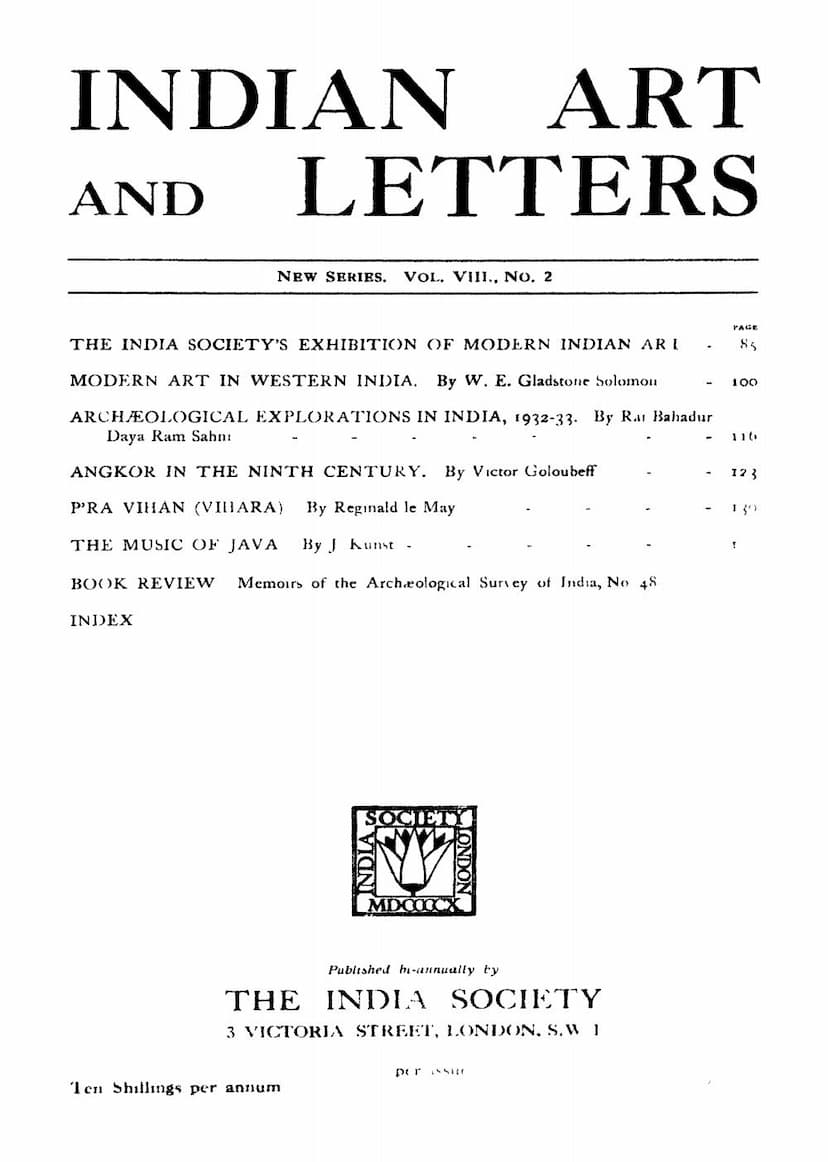Indian Art And Letters
Added to library: September 1, 2025

Summary
This document is Volume VIII, Number 2 of "Indian Art and Letters," a journal published by The India Society in London. The issue, dated 1934, showcases a range of topics related to Indian art, archaeology, and culture, reflecting the Society's mission to promote understanding of India's heritage.
The journal features several key articles:
-
"The India Society's Exhibition of Modern Indian Art in London, December, 1934": This section provides a detailed report on a significant exhibition organized by the India Society, highlighting its purpose to introduce contemporary Indian art to the British public. It details the exhibition's opening by the Duchess of York, the support it received from various dignitaries and regional committees in India, and the press luncheon held prior to its opening. The honorary organizer, Mr. John de La Valette, speaks about the Society's long-standing efforts to promote Indian art and the growing renaissance of artistic movements across India. The article emphasizes the importance of this exhibition in fostering a better understanding between India and Britain.
-
"Modern Art in Western India" by W. E. Gladstone Solomon: This article, based on a lecture delivered to the India Society, discusses the art movement in Western India, particularly focusing on the Bombay School of Art. Solomon, the Director of the school, advocates for a balanced approach that integrates European techniques with Indian artistic traditions and aspirations. He stresses the importance of art education and the government's role in supporting it, detailing the successful development of art programs in Bombay. He also touches upon the challenges faced by Indian artists and the need for patronage.
-
"Archaeological Explorations in India, 1932-33" by Rai Bahadur Daya Ram Sahni: This report summarizes the archaeological findings of the period, covering excavations at sites like Harappa, Taxila, and Nalanda. It mentions the discovery of architectural remains, various bronze and stone images, seals, and inscriptions. The article also touches upon scholarly debates, such as the origin of Indus Valley script and the dating of Gandhara reliefs, highlighting the ongoing efforts to uncover and understand India's ancient past.
-
"Angkor in the Ninth Century" by Victor Goloubeff: This article delves into the history and archaeology of the Khmer civilization, specifically focusing on the identification and mapping of the first capital of Angkor, founded by King Yasovarman I. Goloubeff presents findings from archaeological expeditions that help to reconstruct the layout and significance of this ancient city, challenging previous assumptions about the dating and purpose of its monuments like the Bayon.
-
"P'ra Vihān (Vihara) by Reginald le May: This piece offers a detailed description of P'ra Vihān, a significant Khmer hill-temple. Le May recounts his personal journey to the temple and describes its impressive architecture, including the grand staircase, gateways, and the main temple structure perched on a cliff. He positions P'ra Vihān as a crucial marker in the evolution of Khmer art, predating later famous structures like Angkor Vat.
-
"The Music of Java by J. Kunst: This article explores the characteristics of Javanese music, particularly the gamelan orchestra. Kunst discusses the unique scales (pélog and slendro), the static nature of the music compared to dynamic European music, and the various instruments and their functions within the ensemble. He emphasizes the deeply ingrained cultural significance of music in Java and its role in everyday life, while also reflecting on the challenges of appreciating foreign musical traditions.
The issue also includes book reviews, notably of "Memoirs of the Archaeological Survey of India, No. 48. [Explorations in Sind.]" by N. G. Majumdar, praising its scientific rigor and valuable contributions to understanding the Indus Valley civilization.
Finally, "The India Society" section provides an overview of the organization's mission, history, activities (lectures, exhibitions, publications), and membership terms. It reiterates the Society's commitment to promoting a deeper appreciation of India's rich cultural heritage, free from political entanglements.
In essence, this issue of "Indian Art and Letters" serves as a comprehensive record of the India Society's engagement with Indian culture in 1934, showcasing advancements in the understanding and appreciation of both traditional and contemporary Indian art and archaeology, alongside insights into broader Asian cultural contexts like Javanese music.